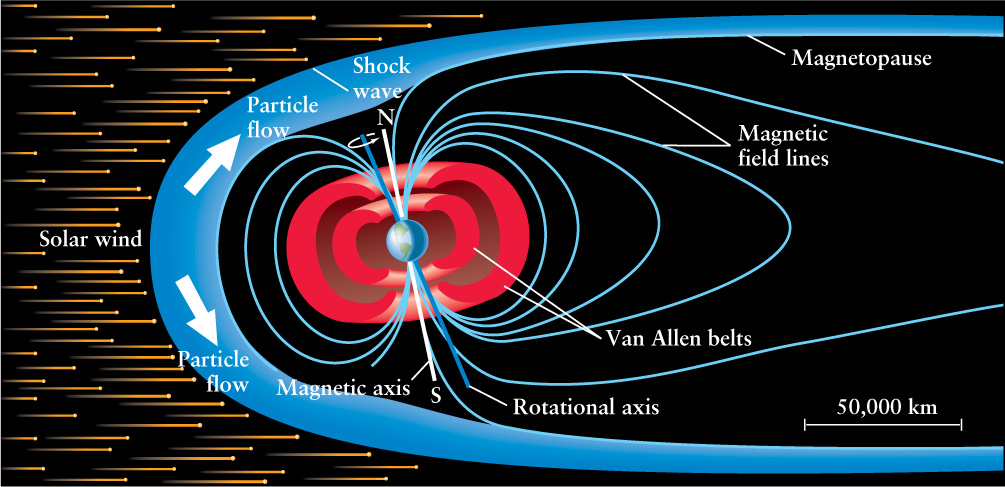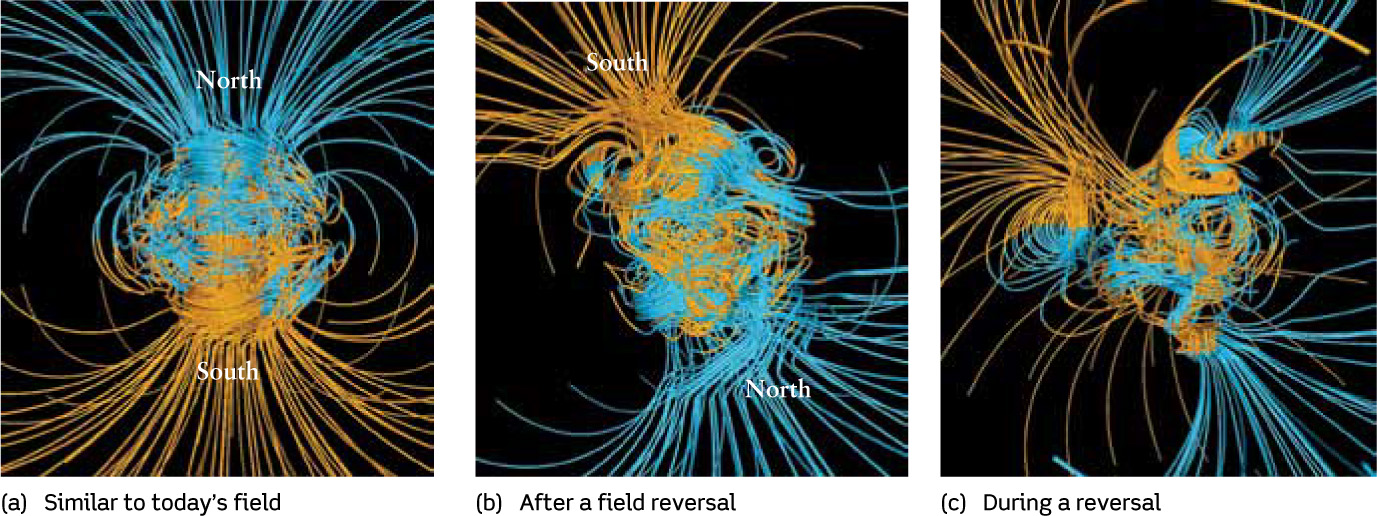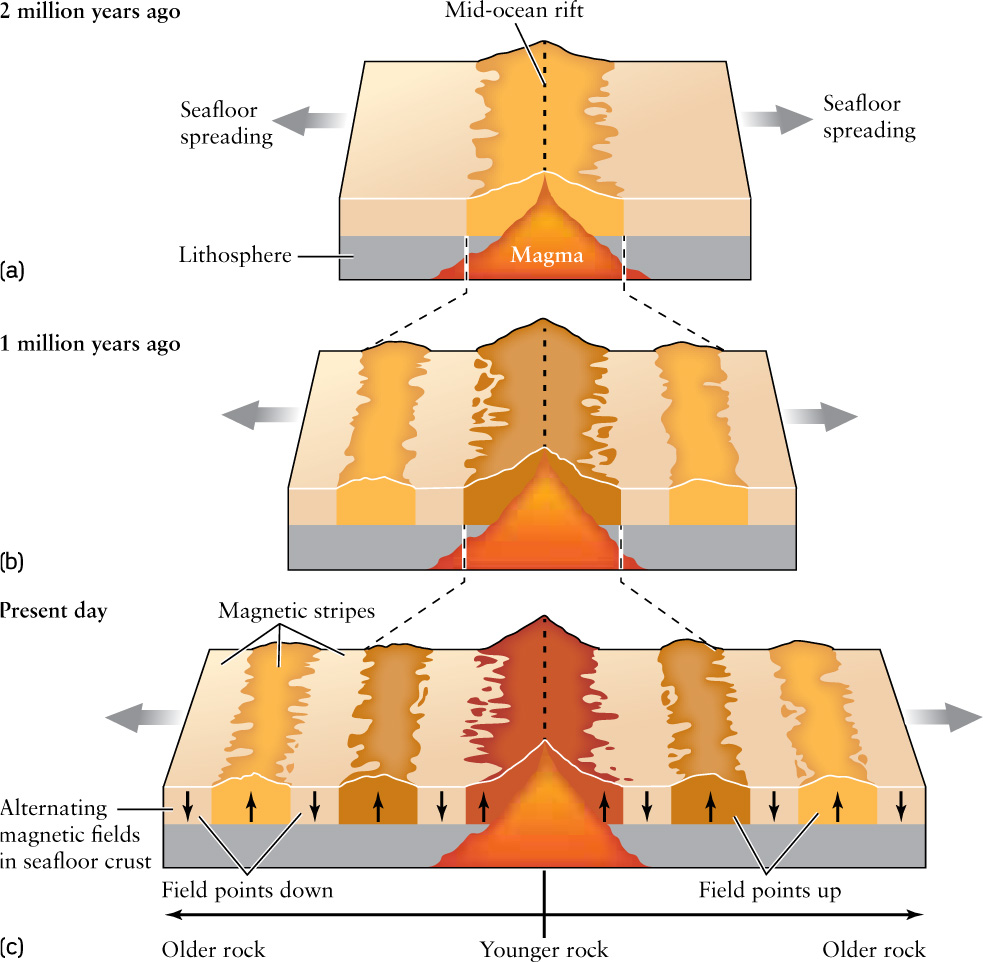9-4 Earth’s magnetic field produces a magnetosphere and reverses direction
We saw in Section 7-7 that Earth’s magnetic field provides evidence that our planet’s interior is partially molten. While the magnetic field is generated deep inside Earth, it has effects on our surface, our atmosphere, and even in the solar system.
The Magnetosphere
Earth’s magnetic field extends far above the atmosphere, where it interacts dramatically with charged particles from the Sun. This solar wind is a flow of mostly protons and electrons that streams constantly outward from the Sun’s upper atmosphere. Near Earth, the particles in the solar wind move at speeds of roughly 450 km/s, or about a million miles per hour. Because this is considerably faster than sound waves can travel in the very thin gas between the planets, the solar wind is said to be supersonic. (Because the gas between the planets is so thin, interplanetary sound waves carry too little energy to be heard by astronauts.)
If Earth had no magnetic field, we would be continually bombarded by the solar wind. But our planet does have a magnetic field, and the forces that this field can exert on charged particles are strong enough to deflect them away from us. The region of space around a planet in which the motion of charged particles is dominated by the planet’s magnetic field is called the planet’s magnetosphere is a scale drawing of Earth’s magnetosphere, which was discovered in the late 1950s by the first satellites placed in orbit.

When the supersonic particles in the solar wind first encounter Earth’s magnetic field, they abruptly slow to subsonic speeds. The boundary where this sudden decrease in velocity occurs is called a shock wave. Still closer to Earth lies another boundary, called the magnetopause, where the outward magnetic pressure of Earth’s field is exactly counterbalanced by the impinging pressure of the solar wind. Most of the particles of the solar wind are deflected around the magnetopause, just as water is deflected to either side of the bow of a ship.
Some charged particles of the solar wind manage to leak through the magnetopause. When they do, they are trapped by Earth’s magnetic field in two huge, doughnut-shaped rings around Earth called the Van Allen belts. These belts were discovered in 1958 during the flight of the first successful U.S. Earth-orbiting satellite. They are named after the physicist James Van Allen, who insisted that the satellite carry a Geiger counter to detect charged particles. The inner Van Allen belt, which extends over altitudes of about 2000 to 5000 km, contains mostly protons. The outer Van Allen belt, about 6000 km thick, is centered at an altitude of about 16,000 km above Earth’s surface and contains mostly electrons.
Aurorae
Sometimes the Van Allen belts become overloaded with particles. The particles then leak through the magnetic fields at their weakest points and cascade down into Earth’s upper atmosphere, usually in a ring-shaped pattern (Figure 9-20a). As these high-speed charged particles collide with atoms in the upper atmosphere, they excite the atoms to high energy levels. The atoms then emit visible light as they drop down to their ground states, like the excited gas atoms in a neon light (see Section 5-8). The result is a beautiful, shimmering display called an aurora (plural aurorae). These are also called the northern lights (aurora borealis) or southern lights (aurora australis), depending on the hemisphere in which the phenomenon is observed. Figure 9-20b and Figure 9-20c show the aurorae as seen from orbit and from Earth’s surface. Aurorae have also been seen on Jupiter and Saturn, and detailed studies of aurorae on Earth have led to a clear interpretation of these distant light-rings on other worlds. For example, by spotting an aurora, we can quickly say that a planet probably has an electrically conductive fluid interior that is in motion and produces a global magnetic field!

 The Aurora An increased flow of charged particles from the Sun can overload the Van Allen belts and cascade toward Earth, producing aurorae. (a) This false-color ultraviolet image from the Dynamics Explorer 1 spacecraft shows a glowing oval of auroral emission about 4500 km in diameter centered on the north magnetic pole. (b) This photograph shows the aurora australis over Antarctica as seen from NASA’s IMAGE satellite. (c) This view from Alaska shows aurorae at their typical altitudes of 100 to 400 km. The green color shows that the light is emitted by excited oxygen atoms in the upper atmosphere.
The Aurora An increased flow of charged particles from the Sun can overload the Van Allen belts and cascade toward Earth, producing aurorae. (a) This false-color ultraviolet image from the Dynamics Explorer 1 spacecraft shows a glowing oval of auroral emission about 4500 km in diameter centered on the north magnetic pole. (b) This photograph shows the aurora australis over Antarctica as seen from NASA’s IMAGE satellite. (c) This view from Alaska shows aurorae at their typical altitudes of 100 to 400 km. The green color shows that the light is emitted by excited oxygen atoms in the upper atmosphere.
Occasionally, a violent event on the Sun’s surface sends a particularly intense burst of protons and electrons toward Earth. The resulting auroral display can be exceptionally bright and can often be seen over a wide range of latitudes. Such events also disturb radio transmissions and can damage communication satellites and transmission lines.
It is remarkable that Earth’s magnetosphere, including its vast belts of charged particles, was entirely unknown until a few decades ago. Such discoveries remind us of how little we truly understand and how much remains to be learned even about our own planet.
Earth’s Magnetic Field Reverses Direction
Earth’s magnetic field is produced by a dynamo. While a full description is beyond the scope of this book, there are several key ingredients to a magnetic dynamo. A dynamo requires an electrically conductive rotating fluid. All electricity produces magnetic fields, and the rotation is necessary to keep the electricity flowing. Far from being solely of interest for Earth’s geology, understanding the magnetic dynamo will help us understand the Sun, Mars, and moons around Jupiter.
Like the motions of tectonic plates, Earth’s magnetic field results from our planet’s internal heat
In the dynamo, heat is required for convection in the liquid iron core. Recall (Section 9-1) that heat is released when water condenses from a vapor to a liquid, and this adds to a storm’s energy. (Imagining the reverse is very easy: Heat is required to turn liquid water into steam.) Similarly, energy is released when material from our planet’s liquid core cools and solidifies onto the solid core. This released energy powers convection of the liquid core, which combines with Earth’s rotation to generate Earth’s magnetic field. (While there is also fluid motion in the mantle, it does not produce an appreciable magnetic field: The silicon-rich rocks that comprise the mantle are poor conductors of electricity, and their motions are a million times slower than those in the outer core.)
If Earth was a permanent magnet, like the small magnets used to attach notes to refrigerators, it would be hard to imagine how our magnetic field could spontaneously reverse direction. But in a magnetic dynamo, computer simulations show that fields produced by electrical currents in Earth’s liquid iron core would reverse direction from time to time (Figure 9-21). The flip of Earth’s field is irregular, but occurs on average about every 300,000 years. The most recent reversal occurred 780,000 years ago—before that flip, a compass needle would have pointed south, not north! While Earth’s present-day magnetic field varies, the evidence does not suggest we are heading toward another field flip anytime soon.

A historical record of Earth’s magnetic field is found in the magnetized crust of the ocean seafloor. As illustrated in Figure 9-22, the seafloor indicates repeated reversals of Earth’s magnetic field. As lava is cooled by seawater at a mid-ocean rift, the newly formed rocky crust is magnetized by Earth’s magnetic field. The magma is too hot to hold a magnetic field before it solidifies, and upon cooling, the magnetic field it acquires is preserved in the oceanic crust. As seafloor spreading continues over time (Section 9-3), this magnetized rock is carried away, in a somewhat symmetric pattern on both sides of the rift. Now imagine what happens if Earth’s magnetic field reverses direction. While the older magnetized rock is carried away, new lava rises and cools at the rift, getting magnetized by Earth’s newly reversed field. The result is magnetic stripes, where the magnetic field alternately points mostly up and down (see the magnetic field penetrating Earth in Figure 7-13b).

Magnetic stripes—and all they imply about a molten interior and plate tectonics—are a compelling example of how phenomena discovered on Earth shed light on other worlds in the solar system. Consider the magnetic stripes on Mars shown in Figure 7-15. Generations of scientists have pieced together the story that these stripes tell on Earth, and with one orbiting magnetometer, a similar story might be revealed on Mars!
CONCEPT CHECK 9-6
If Earth’s iron-rich core solidified, would a magnetic compass still point north?
No. Earth’s magnetic field is predominantly created by a dynamo effect caused by the movement of iron-rich material in the liquid core.
CALCULATION CHECK 9-3
If the seafloor spreads away from a rift at 2 cm/yr, and Earth’s magnetic field points in the same direction for 300,000 yr before flipping, how many km wide is the resulting magnetic stripe?
The width of the stripe is (speed) × (time) = (2 cm/yr) × (300,000 yr) = 600,000 cm. 1 km = 105 cm, so the width is (6 × 105 cm) × (1 km/105 cm) = 6 km wide (or about 3.7 miles).